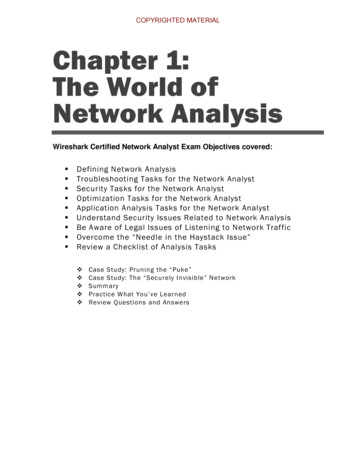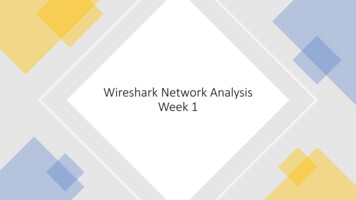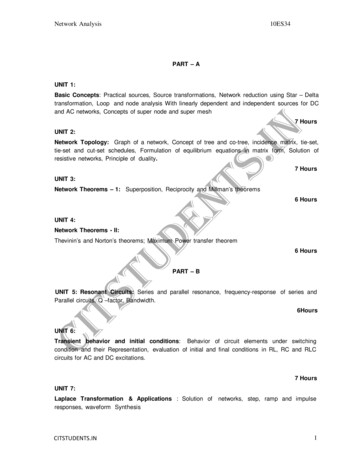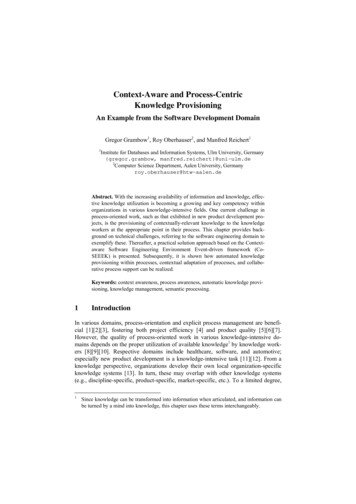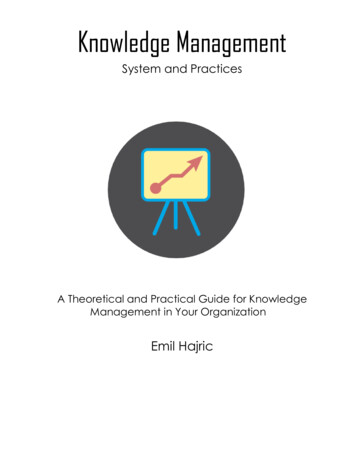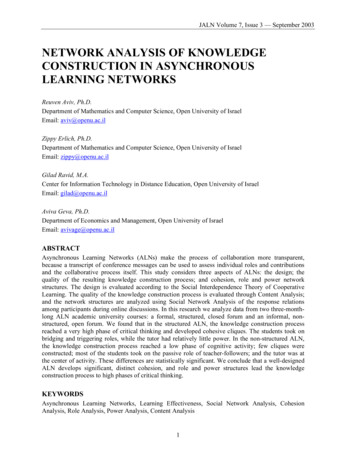
Transcription
JALN Volume 7, Issue 3 — September 2003NETWORK ANALYSIS OF KNOWLEDGECONSTRUCTION IN ASYNCHRONOUSLEARNING NETWORKSReuven Aviv, Ph.D.Department of Mathematics and Computer Science, Open University of IsraelEmail: aviv@openu.ac.ilZippy Erlich, Ph.D.Department of Mathematics and Computer Science, Open University of IsraelEmail: zippy@openu.ac.ilGilad Ravid, M.A.Center for Information Technology in Distance Education, Open University of IsraelEmail: gilad@openu.ac.ilAviva Geva, Ph.D.Department of Economics and Management, Open University of IsraelEmail: avivage@openu.ac.ilABSTRACTAsynchronous Learning Networks (ALNs) make the process of collaboration more transparent,because a transcript of conference messages can be used to assess individual roles and contributionsand the collaborative process itself. This study considers three aspects of ALNs: the design; thequality of the resulting knowledge construction process; and cohesion, role and power networkstructures. The design is evaluated according to the Social Interdependence Theory of CooperativeLearning. The quality of the knowledge construction process is evaluated through Content Analysis;and the network structures are analyzed using Social Network Analysis of the response relationsamong participants during online discussions. In this research we analyze data from two three-monthlong ALN academic university courses: a formal, structured, closed forum and an informal, nonstructured, open forum. We found that in the structured ALN, the knowledge construction processreached a very high phase of critical thinking and developed cohesive cliques. The students took onbridging and triggering roles, while the tutor had relatively little power. In the non-structured ALN,the knowledge construction process reached a low phase of cognitive activity; few cliques wereconstructed; most of the students took on the passive role of teacher-followers; and the tutor was atthe center of activity. These differences are statistically significant. We conclude that a well-designedALN develops significant, distinct cohesion, and role and power structures lead the knowledgeconstruction process to high phases of critical thinking.KEYWORDSAsynchronous Learning Networks, Learning Effectiveness, Social Network Analysis, CohesionAnalysis, Role Analysis, Power Analysis, Content Analysis1
JALN Volume 7, Issue 3 — September 2003I. INTRODUCTIONAsynchronous Learning Networks (ALNs) offer new possibilities for study that were not available intraditional learning models. The pedagogical advantages of online collaborative learning are wellknown [1, 2]. Certain implementations of collaboration are more successful than others. According toMason and Bacsich [3], the degree of integration of online collaborative learning within a courseradically influences its acceptance by students. An ALN makes the collaboration process moretransparent, because a transcript of conference messages can be used to assess both the collaborativeprocess itself, and individual roles and contributions to the process [4].ALN studies call for a greater research focus on the ways peer interaction determine learningoutcomes [5, 6]. The Social Interdependence Theory of Cooperative Learning [7] suggests thatinteraction processes are determined by how social relations among members of the group aredesigned into the learning environment.Johnson and Johnson [7] specified the required design characteristics for effective cooperation.Briefly, the requirements are that participants form promotive (i.e., face-to-face, close togetherinteraction, not across the room), formal, cooperative groups, with positive interdependence betweenparticipants (including deliverable, task, resource, role and reward interdependence), inclusion ofgroup reflection processes, and enforcement of individual accountability and interaction. In addition,certain social skills (trusting others, accurate communication, acceptance and support of others,conflict resolution) are required. Numerous studies have demonstrated that these designcharacteristics are necessary conditions for high achievement [7, 8]. Aviv [9] noted that inasynchronous (virtual) cooperation, the design should be extended to include bridging and triggeringroles—bridging to silent students and triggering after silent periods. Geva [10] demonstrated thatcombining text-based learning with an asynchronous seminar, designed as a formal cooperative groupwith reward mechanisms and on a tight schedule, enriched both the individual and the group learningprocesses.It was found [11] that it is not easy to move students through the phases of critical thinking, yet onlinelearning would seem to favor cognitive tasks. One can quantify the quality of the knowledgeconstruction process in online cooperative learning through Content Analysis of the transcript ofcommunications among the participants. Several models have been proposed. Henri [6] suggested fiveparameters, two of which measure critical thinking (cognitive and meta-cognitive) phases. Using thatmodel, Aviv [9] demonstrated that implementing an extended version of Johnson and Johnson’sdesign in an asynchronous online discussion led to the highest phases of cognitive communication,compatible with the goal of cooperation. The difficulties which arose in using Henri’s model ledGunawardena, Lowe and Anderson [12] to suggest a new Interaction Analysis Model, which we usedin this research.Once the design is implemented and the learning process starts, social relations develop amongparticipants. These social relations control the learning outcomes; in particular, the knowledgeconstruction process. Studying these relations is the focus of this research, using Social NetworkAnalysis (SNA). SNA methods (explained in section II) quantify social relations in terms of networkstructure parameters which encode certain causal group forces. Burt [13] identified the causal forceencoded in cohesion structures that control shared beliefs and behaviors. As mentioned above, certainroles need to be taken on to ensure that group function is uninterrupted and that no one is left behind.Roles affect the distribution of power among ALN participants. SNA can identify cohesion, role andpower structures of the ALN.2
JALN Volume 7, Issue 3 — September 2003We assume that cohesion, role and power distribution control the construction of knowledge. Fromthis assumption, it follows that different design characteristics of online discussion groups result insignificant differences in network structures leading to different phases of critical thinking. We testthis assertion by analyzing the recorded data of two online cooperative learning discussion groupswith a marked distinction in their designs. The proof of this assertion is the major contribution of thispaper.The paper is structured as follows: Section II provides background information regarding the twoanalytic schemes, Content Analysis and Social Network Analysis. Section III details research goalsand questions. Section IV describes the two ALNs that served as a test-bed, the data sources and theirpre-processing. Section V provides Content Analysis of the two ALNs. Sections VI, VII and VIII aredevoted to cohesion analysis, role analysis, and power analysis of the two ALNs, respectively. Insection IX we attempt to model the ALNs using simple symmetrical graphs, discussing the results andlimitations of the analysis in section X. Section XI presents an outline of future work. The appendixgives a supplemental explanation with the technical details of the role analysis.II. THEORETICAL BACKGROUNDA. Content AnalysisAs early as 1990, Hiltz [14] and Mason [15] suggested that analyzing transcripts of asynchronous(text-based) communication could enable quality assessment of the learning process and its outcomes.Henri provided a detailed model for the analysis [6]. Henri’s model relies on breaking down thetranscript into “units of meaning” (a message or a part of it), and classifying these units intocategories and sub-categories according to expressions within the units. In particular, two of thecategories express critical-thinking phases of knowledge construction: cognitive and meta-cognitiveactions. This model has been used successfully in several transcript analyses to identify high phases ofcritical thinking [16]. Gunawardena and colleagues [12] noted that Henri’s model integrates the“participation” category within categories of critical thinking. They also emphasized difficulties inidentifying “units of meaning.” Moreover, Henri’s model emphasizes critical thinking phases ofindividual students, but not of the group process. To overcome these difficulties and simplify practicalanalysis, Gunawardena and colleagues suggested a five-phase Interaction Analysis Model, gearedtowards answering two questions: “What degree of knowledge construction is achieved by thecooperative group?” and “What degree of evidence is there that the knowledge of individualparticipants changes?” In general, the first question is answered by the dominant cognitive phaseobserved in the transcript, while the second question is answered by individual expressions whichdirectly relate to such changes (meta-cognition) or expressions which demonstrate the application ofchanged knowledge.Specifically, the Interaction Analysis model specifies that Knowledge Construction Process proceedsthrough five phases; accordingly, messages (or parts thereof) should be classified into the associatedphases of critical thinking. The model defines five phases:1. Sharing/Comparing Knowledge2. Discover/Explore disagreements3. Synthesis via negotiating meaning4. Testing/modifying proposed synthesis vs. schemas, theory, facts, beliefs3
JALN Volume 7, Issue 3 — September 20035. Proofs of reaching agreements or meta-cognitive admitting change of knowledge.Thus, knowledge construction processes of different cooperative scenarios will differ in the phasesthey reach, as expressed in the associated transcripts.Gunawardena and colleagues used their model to analyze a global online debate (which actuallyserved as the basis for developing their model) and another social-like online ALN. The formerreached phase 3, whereas the latter only reached phase 1. De Laat [17] used the same InteractionAnalysis model to analyze another online ALN which did not go beyond phase 1. Both authors notedthat, in retrospect, these results matched the designs of the ALNs. In general, in assessing the successor failure of an ALN, one should consider the aims of the ALN and its design. One should not expectthe Knowledge Construction Process to reach phase 4 (testing) if it was not designed to do so.We use the Interaction Analysis model to analyze the two ALNs described in section IV.B. Social Network AnalysisSocial Network Analysis (SNA) is a useful tool for studying relations. It is a collection of graphanalysis methods that researchers developed to analyse networks in social sciences, communicationstudies, economics, political science, computer networks, and others. SNA methods provide precisemathematical definitions of five groups of characteristics of the actors and of the network itself [18,19]: cohesion, equivalence (role-groups), power of actors, range of influence, and brokerage. Thesecharacteristics are expressed in terms of corresponding Network-Structure parameters derived fromthe relations among the actors. An introduction to SNA can be found in Scott [20] and Hanneman[21]. For a comprehensive text, see Wasserman and Faust [22]. Burt [13] elaborates on the insightsthat can be obtained from the various values of the network structures.A “social network” is defined as a group of collaborating (and/or competing) entities that are relatedto each other. Mathematically, this is a graph (or a multi-graph); each participant in the collaborationis called an actor and depicted as a node in the graph. Valued relations between actors are depicted aslinks between the corresponding nodes. Actors can be persons, organizations, or groups—any set ofrelated entities.SNA is used in a wide range of applications, from analyzing relations within families [23] to analysisof a Military C4ISR (Command, Control, Communications, Computers and Intelligence, Surveillance,and Reconnaissance) network [24]; from analyzing the positions of adolescents in social networks andtheir sexual experience [25] to analyzing political power networks [26]; from analyzing managementstructures in multi-national corporations [27] to analyzing terrorist networks [28]. The website of theassociation of researchers, INSNA [29], provides links to journals, mailing lists and other resources.Recently Garton, Haythornwaite and Wellman [30] suggested using SNA methods for analyzingonline networks, in particular learner networks. Several authors have demonstrated the applicability ofSNA to specific learning situations. In these studies, the collaborating persons (students, tutors,experts, and so) are the actors. Links between a pair of actors represent the amount of communicationbetween them. Most researchers concentrated on analyzing the distribution of power (or centrality) inthe resulting network. Martinez and colleagues [31] compared the centrality of inter-group and intragroup communication. Power distribution characteristics of multi-relation networks have beenanalyzed by Haythornthwaite [32]; she analyzed time variation as well as media communication4
JALN Volume 7, Issue 3 — September 2003channel dependence of the network power distribution. Cho, Stefanone and Gay [33] found thatpowerful actors in web-based communication are also more influential than others as referrals. Reffayand Chanier [34] concentrated on the evolution of cohesion in learning groups. De Laat [17]combined SNA with Content Analysis and demonstrated that the interaction patterns in the analyzedcourse were centralized and that the Knowledge Construction Process focused on sharing andcomparing information (that is, concentrated on phase one). This line of research is growing fast: asearch for “Social Network Analysis” in a recent Computer Supported Collaborative Learning(CSCL) conference [35] revealed 91 papers.III. THE RESEARCH HYPOTHESISThis work stems from the constructivist paradigm [36], in which knowledge is constructedcooperatively through social negotiation. In online discussion groups, relations are created viamessages. Simply exchanging messages is not enough, however. As noted by Rafaeli [37], theemphasis should be on the responsive nature of the communication. We therefore focus on analyzingstructures of responsiveness relations between participants in the ALN.Cohesion is a primary network structure that contributes to the creation of knowledge: shared beliefsand behaviors [13]. Cohesion is manifested by the existence of cliques of participants who areconnected internally more than externally. Members of a clique tend to create knowledge by virtue oftheir strong intra-responsiveness relations. They drive the process of constructing knowledge.Cohesion in itself does not guarantee that no member will be isolated, nor can it ensure uninterruptedcommunication. Certain tasks need to be performed for cohesion to occur. For example, membersshould communicate with otherwise isolated members. Others should make sure that the feed ofresponses does not stop. These roles may be pre-assigned, but in the absence of such assignments,various group members should take on these roles implicitly. Undertaking these roles duringcollaboration affects the distribution of power among the participants of the ALN. SNA providesprocedures for identifying role and power structures within a given network.We will examine the recorded data of two ALNs. Each of the ALNs is modeled as a KnowledgeConstructing network: the actors are the students and the tutor, the participants in the ALNs; actors arerelated to each other by response messages. We hypothesize that network-cohesion forces, roles andpower structures are major factors in determining the quality of the knowledge construction process.In other words we assert that:A marked difference in the design of ALNs is associated with marked distinctions in thecohesion, role and power structures of the ALNs, which are associated with a marked distinctionin the critical thinking phases of the knowledge construction processes.IV. THE TEST-BEDThe analysis in this research is based on recorded data from two ALNs that were part of the OpenUniversity of Israel course, Business Ethics. The first ALN (18 participants) ran during the fall 2000semester. The other ALN (19 participants) ran during the spring 2002 semester. The designs of theALNs were different. Neither of the ALNs fulfills all of the specifications of Social InterdependenceTheory of Cooperative Learning, but the fall 2000 ALN was more structured than the spring 2002ALN. We will refer to these ALNs as the structured ALN and the non-structured ALN, respectively.5
JALN Volume 7, Issue 3 — September 2003The structured ALN was a three-month long, formal online seminar; in signing up for it, studentscommitted themselves to active participation and other requirements. A reward mechanism forfulfilling the requirements (including active participation) was employed. 18 students opted toparticipate in this ALN. Geva [10] has described the course and the online seminar. Relevant detailsrelating to the structured ALN follow.Students were asked to simulate the role of an advisory committee to a high-tech company(“Cellularphone”). Their problem was stated as follows [10]:“The subject of the seminar this semester is the safety of cellular phone emissions. Existing data andstudies do not rule out the possibility that radiation from cellular telephones causes ill health effects.The cumulative balance against cellular phones today has not yet changed the industry policy.You are required to determine what a morally responsible company (e.g. Cellularphone) should do,based on the assumption that it wants to fulfill its goal as a profit-oriented organization in a set ofcircumstances which is not entirely clear.”The structured ALN was designed as a sequence of 5 steps, according to a well-known phase modelof moral decision-making [38]. In the first step (four weeks), the students were to identify the variousfacets of the problem, debate solutions and propose a synthesis. In the next three steps (2-3 weekseach), the synthesized solution was to be tested against several sets of principles. In the last step (oneweek—if the resolution passed the last test), a summary of the proposal was to be reported. Thesequencing was broadly controlled by the tutor, who began and ended each step according to aprescribed schedule.The non-structured ALN was a three-month long online conference, open to all 300 students in thecourse, with no need to register or commit themselves in advance. No specific cooperative goal wasdefined for this ALN. Students and the tutor could raise a variety of issues related to the course topics(which were the same as in the fall 2000 course). No structure was designed and no schedule wasimposed (though the deadlines for submitting assignments were reflected in the ALN), and no rewardmechanism was implemented. 19 students opted to use this ALN. Table 1 summarizes the design ofthe two ALNs.6
JALN Volume 7, Issue 3 — September 2003Structured ALNRegistrationYesCooperation commitmentYesGoal-directed schedulingYesPredefined work procedures YesResource interdependenceYesWork interdependenceYesReward mechanismYesReward interdependenceNoPre-assigned rolesNoReflection proceduresNoIndividual accountabilityYesNon-structured ALNNoNoNot relevantNoNoNoNot relevantNoNoNoNot relevantTable 1: Design of the two ALNsA. Data SourcesThe ALNs of Business Ethics are accessible by username and password from the TELEM website athttp://telem.openu.ac.il/.The ALNs are in Hebrew, maintained by the Open University of Israel Opus Learning ManagementSystem. Each ALN is a collection of threads. Each thread begins with an initial message sent by amember of the ALN. Other messages in the thread are responses to a predecessor message.1Z3External EntityAN4526ZAR7L89AAFigure 1. Thread Response TreeThe messages contained in a thread can be represented by a Thread Response Tree (Figure 1). In thisfigure, ALN members are represented as labeled nodes. A message is represented as an arc from thenode of the sender of the message to the node of the sender of the predecessor message. The initialmessage is considered a response to an instruction from an “external entity”. Thus, the thread7
JALN Volume 7, Issue 3 — September 2003presented in Figure 1 includes 9 messages: Message 1 was sent by Z in response to the “externalentity”. Messages 2 (from N), 3 (from A) and 6 (from R) in this thread are responses to Message 1.Message 4 (from Z) is a response to Message 3. Message 5 (from A) is a response to Message 4.Messages 7 (from L) and 9 (from A) are responses to Message 6, and Message 8 (from A) is aresponse to Message 7.B. Preparation for Social Network AnalysisThe Social Network Analysis was performed using Cyram NetMiner —a software tool for exploratorynetwork data analysis and visualization [39]. We developed a Visual Basic conversion program,Opus2Ntf.exe, that scans the SQL database of the messages of a given ALN, thread after thread,constructing the response trees. From the response trees, it constructs the response matrix of the ALN.Rows and columns of a response matrix are labeled with numbers representing the members(including the external entity, which was labeled “-1”). The (i, j) entry—that is, row i, column j—isthe number of messages sent by member i as responses to predecessor messages sent by j during thelife of the ALN. The content of the response matrices was then written by Opus2Ntf.exe into data filesin ntf format which is acceptable for analysis by NetMiner.Actors are conceived as sending response messages among themselves. These exchanges define theresponsiveness relation between the actors. The two values of this relation (one in each direction), forany pair of actors i and j, are the (i, j) and (j, i) elements of the response matrix of the online ALN.Mathematically, we have a valued directed network model. A more general network model consists ofa set of actors and one or more directed (or undirected) relations called layers. Our models of thestructured and non-structured ALNs contain a single layer: the responsiveness layer.Note that the model does not capture all the details of the real ALN. For example, in the ALN, aresponse from member A to a previous message sent by B is actually broadcast to all members. Yet,in the model, this is represented by a message sent directly from the actor representing A to the actorrepresenting B. The model concentrates on the trigger/response mechanisms.Also note that the “-1” actor who represents the external entity (to whom all initial messages respond)cannot be analyzed in the same way as other actors in the network: It has a fixed location in thethread response trees (always at the root); it always has one child (there is only one initial message inevery thread); and it never responds. The “-1” actor, then, has no outgoing arcs, and the number of itsingoing arcs is equal to the number of threads. These properties make the “-1” actor rather special.Including it in the analysis would almost certainly result in revealing its special roles. In general, thisis desirable. But our first set of analyses aims to identify the relative positions of actors representingreal ALN members in the network structure. This could be biased by including the “-1” actor. Forthis reason we filtered out “-1” and all its (received) messages. In the filtered response matrix, initialmessages (messages that are not responses) are not counted. This does not effect the relations amongall other actors.V. CONTENT ANALYSISThe transcript analysis procedure consisted of reading each message and classifying it as one or moreof the five phases of the Interaction Analysis model [20]. Thus messages were not divided into “unitsof meaning” as in Henri’s model; however, occasionally a message was classified as belonging tomore than one phase. The messages were coded by three researchers. Discrepancies were discussedand a single coding was agreed upon. There were 248 messages in the structured ALN, and 708
JALN Volume 7, Issue 3 — September 2003messages in the non-structured ALN. Table 2 summarizes the results.Table 2 reflects the knowledge construction processes of the two ALNs. Recall that the structuredALN was an online seminar designed as a series of time-bounded steps, specifically directing thestudents to higher phases of critical thinking. The first step consisted of the elaboration of the factsand possible actions that were and were not relevant, gradually approaching a proposition for asolution. In this step, 100 messages were, roughly, equally divided between phase 1, 2, and 3messages. The next three steps were rephrasing and/or testing the proposition against a set ofpredefined principles of the phase model of moral decision-making [19]. This is reflected in a wealthof phase 4 messages that were sent at this stage. Finally, in the last step, some students explicitlystated that they had learned. No application of new knowledge was reported as the entire seminar wasa role-playing simulation. One message summarized the final proposition (which, by the way, was notagreed upon by all participants). We can conclude that the Knowledge Construction Process of thestructured ALN functioned at all phases up to and including phase 4.Phase12345MeaningStructured ALN Non-structured ALNSharing/Comparing information3870Discovery of disagreement/ inconsistency34Synthesis via Negotiation of meaning28Testing against prescribed principles143Summary/Application of Knowledge5Table 2: Classification of messages in the two ALNsThese results are compatible with students’ evaluation of the online seminar: The fall 2000 ALN ofBusiness Ethics received the highest scores on students’ assessment of learning in comparison with all68 courses that were evaluated that semester. Students rated “sense of community” as 3.67 (out of 5),“knowledge construction” as 4.6, and understanding course materials as 4.33.Students in the non-structured ALN were not part of a formal team, so they used the ALN accordingto their own needs. Inspection of the messages reveals that many of the transactions were simpleQ&A, triggered by students’ assignments and other course components. None of these questionsdeveloped into critical thinking. Here the knowledge construction process functioned at the lowestphase, 1. One should note that the non-structured ALN was not a failure. The design of the spring2002 Business Ethics course specified knowledge construction through other learning activities (selfstudy). The associated ALN was designed as a simple Q&A to support learning.VI. COHESION ANALYSISNetworks can be thought of as developing from smaller sub-networks. The smallest sub-network is adyad (two actors exchanging messages). A larger network is a triad, and so on. Cohesion analysis of anetwork consists of identifying the sub-structure architecture of the network.The idea is that “similar actors are tied together by socializing bonds of interaction through whichthey come to share beliefs and behavioral tendencies. Causal force lies in the strength of thecommunication ties” [13]. There are several methods for performing cohesion analysis. Here we will9
JALN Volume 7, Issue 3 — September 2003use the simplest one, the clique method [40]. A clique is a maximal connected sub-network. Table 3shows the result of performing clique analysis on the two ALNs. The fictitious names in the tablerefer to the participants.Note that a clique is not isolated: there might be external actors linked to some members of the clique,but not to all members of the clique. The Cohesion Index is a measure of the degree to which there arestrong links within the clique rather than outside of it (where the strength of a link reflects the numberof responses exchanged along the link). If the cohesion is greater than 1, then the links within theclique are stronger on average than the links with the outside. A precise definition is given by Bockand Husain [40]. Table 3 shows the result of preparing clique analysis on the two ALNs. We usefictitious names: N1-N19 for the non-structured ALN, and P1-P18 for the structured ALN.Non-structured ALNNumber of cliques: 2MembersCohesion indexK1: N18, N11, N73.826K2: N18, N11, N92.000Structured ALNNumber of cliques: 16MembersCohesion indexK1: P2, P8, P11, P10, P93.333K2: P2, P8, P11, P10, P122.786K3: P2, P8, P11, P162.147K4: P2, P8, P6, P122.439K5: P2, P8, P4, P123.073K6: P2, P8, P4, P133.033K7: P2, P8, P13 ,P91.974K8: P2, P8, P13, P161.810K9: P2, P5, P9, P112.388K10: P2, P5, P9, P111.420K11: P2, P5, P12, P111.970K12: P2, P3, P9, P103.200K13: P2, P3, P9, P132.227K14: P2, P3, P12, P103.792K15: P2, P3, P16, P132.217K16: P1, P4, P81.607Table 3: Clique Analysis ReportsFor reference, the tutors were P1 in the structured and N18 in the non-structured ALNs. The cliquesin the two ALNs have similar cohesion indices. But there is a marked distinction between thestructures of the cliques. First, the number of cliques: 2 in the non-structured ALN, 16 in thestructured ALN. Second, in the structured ALN, the students formed relatively large cliques—4 or 5students in each clique (except K16); that is, they maintained response relations with several others.Moreover, the tutor (P1) participated in one clique only (K16). On the other hand, the cliques in thenon-structured ALN included only 2 students and the tutor (N18).Even more striking is the difference between the inter-clique connectivity, maintained by actors whobelong to more than one clique. Table 3 shows that many students in the structu
traditional learning models. The pedagogical advantages of online collaborative learning are well known [1, 2]. Certain implementations of collaboration are more successful than others. According to Mason and Bacsich [3], the degree of integration of online collaborative learning within
